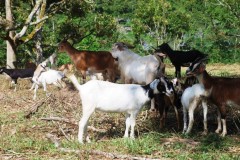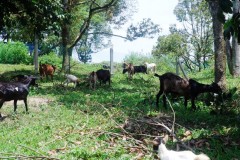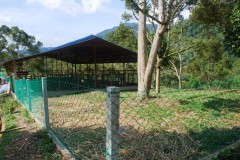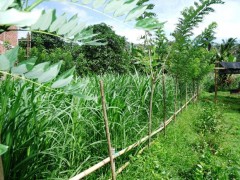May 13, 2010
Sustainable Goat Production System - A Model
Red meat is considered bad for you. But this was not the case 50 years ago. There were tribes then, and still, who consume mainly meat and live normal healthy lives. Some eskimos eat only meat throughout their lives. Nomadic people used to consume only the meat and milk of the animals they herd.
Perhaps the problem lies with how we raise the animals. Here's the lipids content of a sample cut of 100 grams taken from the USDA nutrients database:
Beef - saturated fat: 9.75gms, omega 6: 2.56gms, omega 3: Nil, Cholesterol: 90 mg
Lamb - saturated fat: 11.76gms, omega 6: 2.08gms, omega 3: Nil, cholesterol: 74mg
Chicken - saturated fat 2.6gms, omega 6: 1.87gms, omega 3: 0.03gms, cholesterol: 64mg.
The chicken sample had an oddity, trans fat of 0.105gms. Wonder what are they feeding the chickens, recycled frying oil?
Compare the above with the goat meat produced from our farm:
Saturated Fats : 0.3gms, Omega 6: 140mg, Omega 3: 49.6mg, Cholesterol 51.
The non-existence of omega 3 in industrialised meats as per the samples from the USDA database is worrying for consumer health. The chicken had an omega 6 omega 3 ratio of 62:1. Our goat meat has a ratio of 3:1.
Read here why a low ratio is important for your health.
This is how we produce our goat meat. The goats are happy, the land is happy, the consumer is healthy.


The goats are moved from field to field every 3 to 7 days. This reduces disease and intestinal worm problems.





Grass is planted separately, harvested, and fed to the goats. This ensures better utilization of land and thereby reduce the demand for expanding land acreage.
An acre of land using normal grazing methods can raise a maximum 15 goats. In our case, we can raise 200 goats on an acre of land.
With less disease and better control on the quality of grass that the goats are eating, the net result is happy goats, healthier meat for the consumers and less impact on the environment.
We are the only producer of red meat that can guarantee an omega 6: omega 3 ratio of 4:1 or better (in the world!).
15:18 Posted in Goats | Permalink | Comments (1) | Tags: goat farming, sustainable goat farming, pasture management, omega 6 omega 3 ratio










Comments
Kudos to your farm for achieving an ideal Om6-Om3 ratio in goats meat! In the world!!! Amazing!
You are doing great work as an ecologically-responsible and enlightened farmer!
I only wish you can expand your operations and export to neighbouring countries, such as Singapore.
Posted by: LP | May 27, 2010
The comments are closed.